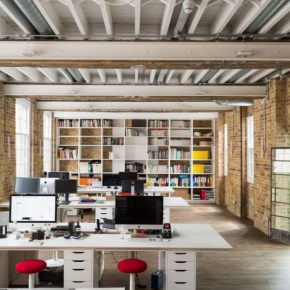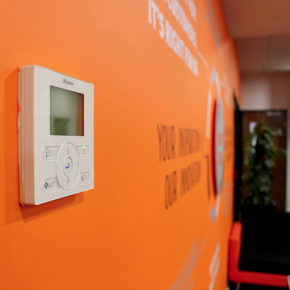
GUEST ARTICLE: Thermal Comfort in the Workplace
This guest article from 361 Degrees looks at WELL Buildings and how air quality can affect a workplace.
“When the poet John Lydgate wrote ‘you can please some of the people all of the time, you can please all of the people some of the time, but you can’t please all of the people all of the time’ he probably wasn’t referring to workplace temperature control.
However, there may be no better way of describing the challenge of maintaining a perfect environment in modern buildings.
The way that each person experiences thermal conditions is different, and there’s no simple explanation of ‘too hot’ or ‘too cold’.
So, when taking a holistic approach to building design, the aim is to consider all of the factors that affect thermal comfort in the workplace, and to ensure that the majority of people experience comfort for a majority of the time.
With colder winters to endure, buildings in the UK are designed to retain warmth. Mainly built from brick, our buildings store heat and slowly release it over a period of time, but with our summers getting warmer, they’re becoming increasingly unreliable at keeping us comfortable, both during and after a heatwave.
A recent study discovered that office productivity drops by 4% when environments are too cold, and by 6% when the office is too hot.
But the effects could go even further, potentially leading to health risks. Looking beyond Sick Building Syndrome, people may start to avoid certain areas of the office that are too cold (potentially to the detriment of their work) or may not wear appropriate personal protective equipment (PPE) if they’re too hot.
When looking at thermal comfort, the Health and Safety Executive outlines six basic factors, and it’s the combination of these factors that affect a person’s perception of their comfort.
- Air temperature: The most common measurement of air temperature surrounding the body. However, alone it does not give us enough information to indicate how comfortable a space is.
- Radiant temperature: With a greater effect on the body, radiant heat sources cause you to feel warmer than a thermometer measuring the air temperature will show us. Think about how the sun heats you up on a winter’s day. The air temperature doesn’t change, but the direct impact of radiant heat on your body can prompt you to remove your coat. The effect is the same indoors, when radiant heat sources cause you to feel warmer than a thermometer measuring air temperature will show.
- Air velocity: We’ve all experienced draughts, and understand how distracting they can be. Cooling your office space to the perfect temperature using blasts of cold air can be disconcerting.
- Humidity: High humidity levels can stump the body’s ability to cool down naturally by sweating, while low humidity contributes to a spread of viruses that can cause irritation.
- Clothing insulation: While environmental factors are more commonly known, workplace policies such as company uniforms or PPE requirements can limit our ability to adapt our wardrobes to the changing environments.
- Metabolic heat: Affected by physical attributes such as age, size and level of fitness, the amount of heat produced by our bodies from physical work should also be taken into account.
The WELL Building approach to making the majority of people comfortable for the majority of the time is to use these parameters to create a model for predicting whether people will be satisfied.
Once these satisfactory conditions are established, they need to be met for 98% of the building’s occupied hours of the year.
That means the designers of a WELL Building need to prove that the sort of weather extremes the building wouldn’t cope with, are expected for no more than 2% of the year.
A more advanced standard included in the WELL criteria assesses humidity control, while looking at the ability of individuals to adjust their own environment.
The control of air speed, air temperature and radiant temperature can drastically improve comfort levels, therefore including policies such as a flexible dress code can have a significant effect on granting more control over personal preferences.
The key to achieving optimal thermal comfort is having the right equipment in the right place, and for the right purpose – so ensuring you have an experienced designer is vital.
By looking at building design with a holistic approach, we can get much closer than ever to pleasing everyone, all of the time.
Latest news

29th April 2025
Senior pledges to ‘bee’ part of the solution with new biodiversity initiative
Senior Architectural Systems has installed its first on-site beehive, marking another step forward in its commitment to sustainability and biodiversity.
Posted in Articles, Building Industry News, Building Products & Structures, Building Services, Curtain Walling, Doors, Glass, Glazing, Innovations & New Products, news, Restoration & Refurbishment, Retrofit & Renovation, Sustainability & Energy Efficiency, Walls, Windows
29th April 2025
West Fraser range delivering key benefits for South-East carpentry company
An experienced carpenter and building site manager who has recently set up his own company is using high performance panel products from the West Fraser range.
Posted in Articles, Building Industry News, Building Products & Structures, Building Systems, Case Studies, Garden, Restoration & Refurbishment, Retrofit & Renovation, Sustainability & Energy Efficiency, Timber Buildings and Timber Products
29th April 2025
CPD Courses Available Online From Ecological Building Systems
Ecological Building Systems, a leading supplier of natural building products for sustainable construction, has revealed its comprehensive CPD programme for the year ahead.
Posted in Articles, Building Industry Events, Building Industry News, Building Products & Structures, Building Services, Continuing Professional Development (CPD's), Information Technology, Innovations & New Products, Insulation, Restoration & Refurbishment, Retrofit & Renovation, Seminars, Sustainability & Energy Efficiency, Training, Walls, Waste Management & Recycling
29th April 2025
WindowBASE launches new prospect databases at FIT Show
Visit WindowBASE at the FIT Show to see first-hand how it helps companies find new customers – the company is launching an easy-to-use, intuitive platform on Stand G16 at the NEC Birmingham from 29th April – 1st May.
Posted in Articles, Building Industry Events, Building Industry News, Building Products & Structures, Building Services, Doors, Exhibitions and Conferences, Glass, Glazing, Information Technology, Innovations & New Products, Posts, Publications, Research & Materials Testing, Restoration & Refurbishment, Retrofit & Renovation, Windows
 Sign up:
Sign up: 
